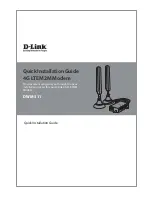
2
EN
GL
ISH
electromagnetic sources, vibration, dust,
excessive moisture, and direct sunlight.
•
Place antennas in an unobstructed area with
clear LTE signal. Avoid metal boxes, brick walls,
and other dense materials. Use the web interface
to confirm signal strength before permanent
installation.
•
Visually inspect the power connector and make
sure that it is fully secure.
•
Do not stack any devices on top of the modem.
Attach the External Antennas
Figure 4: Attaching External Antennas
The DWM-311 requires two external antennas
to function correctly. The included antennas are
interchangeable, but third party antennas may
require connection to specific ports.
1. Attach the antennas to the included magnetic
mounts. Turn the hex nut clockwise to fasten the
antenna.
Figure 5: Attaching Antenna to Magnetic Mount
2. Place antennas where they will receive optimal
signal. Arrange them so they point upward.
Figure 6: Attaching Antenna to Modem
3. Once the antennas are placed, attach both
antenna cables to the DWM-311’s external SMA
connectors, labelled DIV and PRI. Turn the hexnut
clockwise to secure the cables.
Note:
The included antennas are interchangeable.
Third party antennas may require connection to
specific ports.
Powering the Modem
The modem can be powered either directly via
mini-USB or via Power over Ethernet (PoE) using a
PoE splitter.
Using included Mini-USB cable
Use the included mini-USB cable to power the
modem. Attach the USB connector to the included
AC adaptor. Attach the AC adaptor to a wall socket.
Insert the mini-USB connector into the port on the
modem labelled with the symbol. The power LED
will turn green to indicate the modem is receiving
power.
Using PoE
The DWM-311 can be powered via Power over
Ethernet (PoE) by connecting the included 5.5 mm
DC to mini-USB adaptor to a PoE splitter. This may be
useful when long cable lengths required. Standard
PoE has a range of up to 330 ft (100 m). The following
steps outline setting up the modem with a PoE
Splitter/Injector kit (sold separately).








